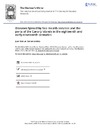Please use this identifier to cite or link to this item:
https://accedacris.ulpgc.es/jspui/handle/10553/52480
| DC Field | Value | Language |
|---|---|---|
| dc.contributor.author | Santana-Pérez, Juan Manuel | en_US |
| dc.date.accessioned | 2018-11-27T11:58:28Z | - |
| dc.date.available | 2018-11-27T11:58:28Z | - |
| dc.date.issued | 2016 | en_US |
| dc.identifier.issn | 0025-3359 | en_US |
| dc.identifier.uri | https://accedacris.ulpgc.es/handle/10553/52480 | - |
| dc.description.abstract | In the Canary Islands the sea was as a defence against disease. There was a constant fear of epidemics arriving by sea, not only because of the potentially high death toll, but because it could have a seriously detrimental effect on trade. As well as the local impact of disease, health control was important because the Canary Islands acted as an important buffer zone in the control of infection in the Spanish–American trade. Central and local administrations were created to manage health and to control the risk of disease entering the ports and to prevent epidemics from spreading to the interior of the islands. All arriving ships were inspected and any suspicious vessels were quarantined to contain any contagion. Specific quarantine areas were designated and these were developed with facilities such as infirmaries for the sick. Despite these measures the administrative control was weak and epidemics spread through the islands on a number of occasions throughout the eighteenth and nineteenth centuries. | en_US |
| dc.language | eng | en_US |
| dc.relation.ispartof | Mariner's Mirror | en_US |
| dc.source | Mariners Mirror [ISSN 0025-3359], v. 102 (3), p. 290-302 | en_US |
| dc.subject | 550404 Historia moderna | en_US |
| dc.subject.other | Board of Health | en_US |
| dc.subject.other | Canary Islands | en_US |
| dc.subject.other | Epidemics | en_US |
| dc.subject.other | Infection control | en_US |
| dc.subject.other | Ports | en_US |
| dc.subject.other | Quarantine | en_US |
| dc.subject.other | Scurvy | en_US |
| dc.subject.other | Smallpox | en_US |
| dc.subject.other | Yellow fever | en_US |
| dc.title | Diseases spread by sea: health services and the ports of the Canary Islands in the eighteenth and early nineteenth centuries | en_US |
| dc.type | info:eu-repo/semantics/Article | es |
| dc.type | Article | es |
| dc.identifier.doi | 10.1080/00253359.2016.1202483 | |
| dc.identifier.scopus | 84979009342 | - |
| dc.identifier.isi | 000381351500005 | |
| dc.contributor.authorscopusid | 38961867800 | - |
| dc.description.lastpage | 302 | - |
| dc.identifier.issue | 3 | - |
| dc.description.firstpage | 290 | - |
| dc.relation.volume | 102 | - |
| dc.investigacion | Artes y Humanidades | en_US |
| dc.type2 | Artículo | en_US |
| dc.contributor.daisngid | 34949817 | |
| dc.contributor.wosstandard | WOS:Santana-Perez, JM | |
| dc.date.coverdate | Julio 2016 | |
| dc.identifier.ulpgc | Sí | es |
| dc.description.sjr | 0,12 | |
| dc.description.sjrq | Q3 | |
| dc.description.ahci | AHCI | |
| dc.description.erihplus | ERIH PLUS | |
| item.fulltext | Con texto completo | - |
| item.grantfulltext | open | - |
| crisitem.author.dept | GIR IATEXT: Documentación, Patrimonio e Historia Atlántica | - |
| crisitem.author.dept | IU de Análisis y Aplicaciones Textuales | - |
| crisitem.author.dept | Departamento de Ciencias Históricas | - |
| crisitem.author.orcid | 0000-0002-9505-9288 | - |
| crisitem.author.parentorg | IU de Análisis y Aplicaciones Textuales | - |
| crisitem.author.fullName | Santana Pérez, Juan Manuel | - |
| Appears in Collections: | Artículos | |
SCOPUSTM
Citations
3
checked on Jun 8, 2025
WEB OF SCIENCETM
Citations
3
checked on Jun 8, 2025
Page view(s)
92
checked on Feb 17, 2024
Download(s)
208
checked on Feb 17, 2024
Google ScholarTM
Check
Altmetric
Share
Export metadata
Items in accedaCRIS are protected by copyright, with all rights reserved, unless otherwise indicated.
